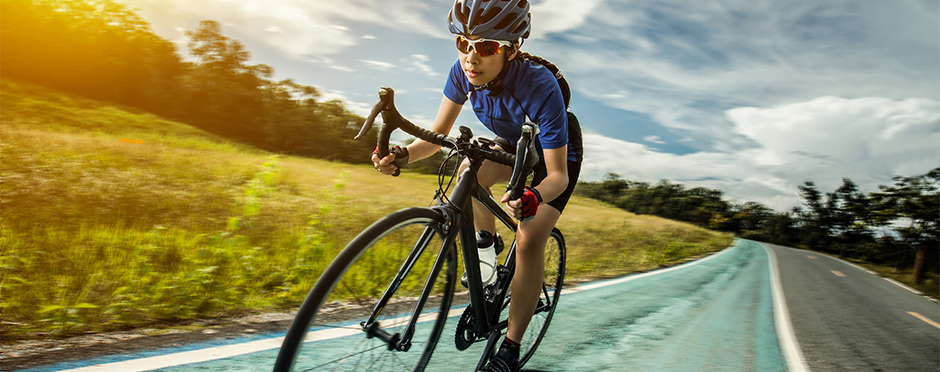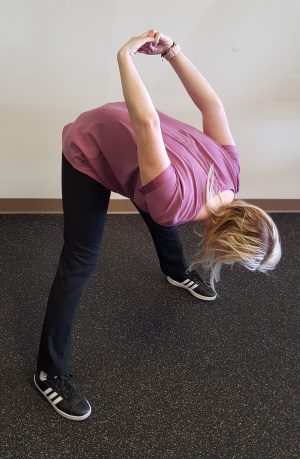
Preventing Cycling Arm and Hand Injuries
2 CommentsAs spring brings warmer weather and adds daylight hours, biking fever spreads!
Although biking is fun and can be good for your health, cyclists should still keep a few things about their bodies in mind before hitting those trails to prevent injury. Given its whole body involvement, cycling can involve a few injuries including ones to the upper body. In fact, one survey found that approximately 31 percent of cyclists reported overuse hand problems.1 So, whether your biking dreams entail off-road adventures or long-distance road cycling, it is important to take precautions to protect your arms and hands from injury, which can arise from one or more of these three causes: improper positioning, sustained positioning or trauma from a fall or collision.
Improper Positioning
Even after buying the correct sized bike and having the seat aligned, a misfit between the cyclist and the bike can occur affecting not only the spine and legs, but also the arms. Symptoms that may signal poor positioning can include numbness and tingling in the ring and small fingers, numbness and tingling in the thumb, index, and middle fingers, clumsiness with tasks involving hand coordination and pain in the arms, wrist, hands and back.
Some common positioning mistakes that can lead to numbness, tingling and wrist and thumb/hand pain include hands being positioned wider than shoulder-width apart and the wrists being angled too far back, forward or inward. These can be addressed by changing handle bars from straight to angled or using aero bars. Wearing padded gloves can also absorb the shock and vibration of the ride as well as allow for a looser grip.
Pain in the back and hands can stem from riding with rounded back and shoulders or with elbows locked in extension and can involve handle bars that are too low or too high in relation to the seat or tight hamstrings.
What is the right position then? The ideal riding position involves a neutral back, slight elbow bend, hands shoulder width apart and wrists in mid-position. Changes in handle bar height and angle (as mentioned above) as well as addition of ergonomic grips, added bar ends, adjustable height or adjustable angle handle bars can all assist to achieve the correct positioning.
If the above necessary positioning modifications are made and the affected body part is rested early enough, the symptoms should resolve within a couple of days. However, if symptoms involve coordination problems with the fingers or have been longstanding, it may take weeks to months to recover and may possibly require seeing a physician that is a hand specialist and/or an Occupational Therapist.
Sustained Positioning
Even with the best bike fit, sustained positioning while riding has the inherent risk of continuous pressure and requires constant shock absorption on the part of vital structures including: blood vessels, nerves, joints and muscles. This can lead to tissue breakdown and inflammation.
This can be especially prevalent with road bikes as their speed and aerodynamics require the trunk to be angled 60-75 degrees forward toward the bars (i.e., the cyclist is not as upright as the off road mountain biker or hybrid biker).2 This position requires strong overall core and upper body conditioning to go faster and/or longer distances. Addressing these areas as part of an overall fitness regimen can help prevent issues while riding.
Another way to counteract pain from sustained positioning is frequently moving the body parts that are typically static during a ride. This can be achieved by changing hand holds every three to five minutes and stretching on breaks or after the ride.
Here are a couple examples of stretches. Perform each stretch for five to ten seconds, repeating five to ten times during each break from riding. Notice that while both stretches involve the hands, they are stretched in opposite directions during each one.


Trauma
While the injuries that occur with bike falls and collisions are as varied as the impacts, two common bones broken are the clavicle (collar bone) and the scaphoid (wrist bone near the thumb). Extending the arm to break a fall focuses forces on these bones leading to injury during impact. Along with potential fractures, the clavicle is also prone to sprain or separation, which could require at a minimum sling usage or surgery depending on severity.
A scaphoid fracture can be easily missed as the telltale sign of this fracture, pain in the thumb side of the wrist, might not be felt as severely initially as other injuries. It is important to be vigilant of an injury in this area, however, as a design flaw in the blood supply to the scaphoid can lead to serious issues including avascular necrosis (failure of bone to heal) and long term functional impairment if not treated early. This is why it is important to not ignore wrist pain after a bike fall.
While prevention of falls and broken bones may not be entirely possible, if the biker holds on to the handle bars while falling, the entire body can absorb the blow of the impact rather than focusing the impact on these two bones in the outstretched arm. Wearing a helmet can also make the need to protect the head less of an issue during a fall.
Enjoying the Ride
By being aware of some of the most common arm and hand-related bike injuries, you can take the necessary steps to prevent these injuries from occurring during your rides. Should an injury occur, schedule an appointment at a nearby Athletico location so that our Occupational Therapists can help you heal in time for the next ride.
The Athletico blog is an educational resource written by Athletico employees. Athletico bloggers are licensed professionals who abide by the code of ethics outlined by their respective professional associations. The content published in blog posts represents the opinion of the individual author based on their expertise and experience. The content provided in this blog is for informational purposes only, does not constitute medical advice and should not be relied on for making personal health decisions.
References
1. Schwellnus, Martin & Derman, Wayne. “Common injuries in cycling: Prevention, diagnosis and management. “ South African Journal of Family Practice/Primary Care, 47/7, PDF, 2005, p 16. https://www.researchgate.net/publication/275065012_Common_injuries_in_cycling_Prevention_diagnosis_and_management.
2. Schmidt, Achim. “Ergotec: The Guide to Cycling Ergonomics.” 2012. CyclingRight.com. Humpert.com. https://www.hr.ubc.ca/ergonomics/files/Bike-Ergonomics-reduced-size.pdf
3. Bledsoe, Jim. “Cycling Injuries-handle bar palsy.” The Sports Injury Bulletin. https://sportsinjurybulletin.com/archive/cycling-injuries.html#
4. Lindsay, Marc. “How to Prevent the 6 Most Common Cycling Injuries.” Active.com. https://www.active.com/cycling/articles/how-to-prevent-the-6-most-common-cycling-injuries/slide-3

2 Comments
Linda
Is it possible to protect wrist and elbow fractures by wearing protective braces of some sort? I am 68 and have not biked in 8 years, and I am so scared of losing my balance while trying to re-learn how to bike! Is getting training wheels my only option???
Thank you!
Athletico
Hi Linda – Thank you for reading the blog. Biking is great exercise and it is good to think it through. Do you already have a bike? If not, an upright will be easier to maneuver than either a road or mountain bike. Recumbent cycling is another option as you are lower to the ground and less likely to get a head or arm injury.
If you already have a bike, you could try training wheels. Definitely use biking gloves. You could try semi-soft supports for the wrist/elbow but you would not want to use rigid supports as you need wrist/elbow movement to maneuver efficiently and safely. Take care and I hope you enjoy your ride!